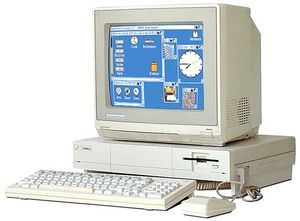Difference between revisions of "Amiga line"
Jump to navigation
Jump to search
| Line 1: | Line 1: | ||
| − | The Amiga is a series of computers released by Commodore, starting in 1985. It was a very powerful and capable machine for its' time, featuring a Motorola 68000 and custom chips dedicated to IO, sound, graphics and more. This family of computers became quite popular, especially in Europe, spawning a huge library of games over time. | + | [[File:A1000.jpg|thumb|The Amiga 1000]]The Amiga is a series of computers released by Commodore, starting in 1985. It was a very powerful and capable machine for its' time, featuring a Motorola 68000 and custom chips dedicated to IO, sound, graphics and more. This family of computers became quite popular, especially in Europe, spawning a huge library of games over time. |
The later Amigas failed to advance vastly on the old models and the family lost it's gain to newer video game consoles and other PC archietectures. Despite this, there are still a handful of loyal Amiga users today and software continues to be developed for the classic machines, as well as a newer line of PPC-based Amigas released in the 2000s and beyond. | The later Amigas failed to advance vastly on the old models and the family lost it's gain to newer video game consoles and other PC archietectures. Despite this, there are still a handful of loyal Amiga users today and software continues to be developed for the classic machines, as well as a newer line of PPC-based Amigas released in the 2000s and beyond. | ||
Revision as of 07:09, 22 July 2013
The Amiga is a series of computers released by Commodore, starting in 1985. It was a very powerful and capable machine for its' time, featuring a Motorola 68000 and custom chips dedicated to IO, sound, graphics and more. This family of computers became quite popular, especially in Europe, spawning a huge library of games over time.
The later Amigas failed to advance vastly on the old models and the family lost it's gain to newer video game consoles and other PC archietectures. Despite this, there are still a handful of loyal Amiga users today and software continues to be developed for the classic machines, as well as a newer line of PPC-based Amigas released in the 2000s and beyond.
